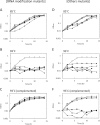Random mutagenesis of a hyperthermophilic archaeon identified tRNA modifications associated with cellular hyperthermotolerance
- PMID: 30605516
- PMCID: PMC6393311
- DOI: 10.1093/nar/gky1313
Random mutagenesis of a hyperthermophilic archaeon identified tRNA modifications associated with cellular hyperthermotolerance
Abstract
Random mutagenesis for the hyperthermophilic archaeon Thermococcus kodakarensis was established by the insertion of an artificial transposon designed to allow easy identification of the transposon-inserted locus. The phenotypic screening was applied for the isolation of thermosensitive mutants of T. kodakarensis, which resulted in the isolation of 16 mutants showing defective growth at the supraoptimal temperature 93°C. The high occurrence of the mutants suggested that the high thermotolerance of hyperthermophiles was achieved by a combination of diverse gene functions. The transposon insertion sites in two-thirds of the mutants were identified in a group of genes responsible for tRNA modifications including 7-formamidino-7-deaza-guanosine (archaeosine), N1-methyladenosine/N1-methylinosine, N4-acetylcytidine, and N2-dimethylguanosine/N2,N2-dimethylguanosine. LC-MS/MS analyses of tRNA nucleosides and fragments exhibited disappearance of the corresponding modifications in the mutants. The melting temperature of total tRNA fraction isolated from the mutants lacking archaeosine or N1-methyladenosine/N1-methylinosine decreased significantly, suggesting that the thermosensitive phenotype of these mutants was attributed to low stability of the hypomodified tRNAs. Genes for metabolism, transporters, and hypothetical proteins were also identified in the thermosensitive mutants. The present results demonstrated the usefulness of random mutagenesis for the studies on the hyperthermophile, as well as crucial roles of tRNA modifications in cellular thermotolerance.
© The Author(s) 2019. Published by Oxford University Press on behalf of Nucleic Acids Research.
Figures




References
-
- Izumi M., Fujiwara S., Takagi M., Fukui K., Imanaka T.. Two kinds of archaeal chaperonin with different temperature dependency from a hyperthermophile. Biochem. Biophys. Res. Commun. 2001; 280:581–587. - PubMed
-
- Usui K., Yoshida T., Maruyama T., Yohda M.. Small heat shock protein of a hyperthermophilic archaeum, Thermococcus sp. strain KS-1, exists as a spherical 24 mer and its expression is highly induced under heat-stress conditions. J. Biosci. Bioeng. 2001; 92:161–166. - PubMed
-
- Kikuchi A., Asai K.. Reverse gyrase–a topoisomerase which introduces positive superhelical turns into DNA. Nature. 1984; 309:677–681. - PubMed
Publication types
MeSH terms
Substances
LinkOut - more resources
Full Text Sources
Other Literature Sources

